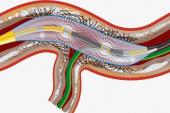Add-on CMS Payment Sweetens Shockwave Choice, but Cost Still Rankles
At $4,700, the new intravascular lithotripsy system was priced high in the hopes of an NTAP. Some say the math still irks them.

The Centers for Medicare & Medicaid Services (CMS) has come through with the anticipated new technology add-on payment (NTAP) for inpatient coronary intravascular lithotripsy (IVL) cases using the Shockwave IVL system and Shockwave C2 coronary IVL catheter, clearing the way for additional reimbursement.
That would be welcome news for operators looking to offset the cost of the new technology recently approved by the US Food and Drug Administration for the treatment of severely calcified coronary plaques. At $4,700, the device cost is considerably higher than that of other calcium-modification tools on the market. With the NTAP, hospitals would receive a maximum of $3,666 for an inpatient procedure involving coronary IVL, although the exact amount will vary on a case-by-case basis.
In recommending that the Shockwave IVL system be eligible for NTAP, CMS stated that the device was designated a breakthrough technology by the FDA and meets all three requirements for the NTAP, according to the company. First, the medical technology is new, and second, it provides a substantial clinical improvement over existing technology. To meet the third requirement for NTAP, the new device must be so costly that the otherwise applicable diagnosis-related group (DRG) bundled payment is deemed inadequate. Shockwave Medical previously told TCTMD that they set the price of the device at a level that will “optimize the future reimbursement of intravascular lithotripsy.”
In other words, it appears it is priced high enough to qualify for NTAP, which generates the additional payment from CMS. The strategy doesn’t exactly sit well with some cardiologists.
“Especially considering where we are at present, having lived through a year of the pandemic and what hospitals, physicians, and staff have gone through financially, the pricing just rubs me the wrong way,” Ajay Kirtane, MD (NewYork-Presbyterian Hospital/Columbia University Irving Medical Center, New York, NY), told TCTMD. “It’s $4,700 for a specialty balloon. That is approximately five times the price of a drug-eluting stent, approximately 50 times the price of a conventional balloon, and I believe significantly more expensive than the peripheral device. Clinically, the data are favorable, but at some point, what does it say about our healthcare system that a company can seemingly state that they have priced the device that much higher to specifically drive extra reimbursement from the government to hospitals if they use it?”
When the IVL device was first cleared by the FDA, a Shockwave spokesperson told TCTMD that other atherectomy devices on the market start at about $2,000, depending on a hospital’s volume commitments to manufacturers, but are as high as $4,000 per procedure at “most” hospitals.
Justin Levisay, MD (NorthShore University Health System, Evanston, IL), pointed out that there are a host of technologies priced through the roof in interventional cardiology, the Shockwave IVL system among them.
“All of these devices when they come out are priced ridiculously high, and then it’s a race to the bottom over time,” Levisay told TCTMD. “Drug-eluting stents when they came out were $3,000, but you can buy a drug-eluting stent for $500 now. The price will come down over time as insurers and Medicare start paying less and less, and they’ll drop their prices eventually. But obviously I wish it weren’t $4,700. The new technology add-on payment, under the best-case scenario, is 65% of the new device, so you’re never going to be made whole.”
Moreover, the CMS add-on payment only applies to procedures performed in the hospital. Shockwave Medical has applied to CMS for the Transitional Pass-Through (TPT) payment for outpatient procedures, with a decision expected sometime this year.
Robert Riley, MD (The Christ Hospital/Lindner Research Center, Cincinnati, OH), agreed that $4,700 is a lot of money for the Shockwave balloon, echoing the observations of others that it is significantly more money than the cost for the majority of atherectomy devices on the market. As such, operators will have to ask themselves in each instance whether they really need to pull IVL from the shelves, or if they can safely make do with standard atherectomy.
“Everything you do in the cath lab is always a series of pros and cons and balancing those, whether it’s putting the patient on the table to begin with, all the way through to device use,” said Riley. If IVL can reduce serious complications even just a little—and that’s never been proven against traditional atherectomy devices—the extra cost of the device could be worth it, he suggested. Moreover, he noted, roughly one in three patients has moderate-to-severe coronary calcification, but not all of these patients today receive effective treatment.
“With other calcium-modifying strategies, like atherectomy, which is the first and foremost thing that people think about, it’s been decades and decades of money spent training people how to use it because it is a different skill set. We have nothing else in our armamentarium like that, and it requires training courses, proctoring, and whatever else how to use it. Despite so much emphasis on teaching and education, use of atherectomy has not budged at all in decades even though the prevalence of significant coronary calcium continues to increase. That’s a problem, that’s a big gap.”
IVL Easier Than Atherectomy, but Cost a Factor
IVL is easier to use than traditional rotational and orbital atherectomy devices, said Levisay, noting that all interventional cardiologists, regardless of skill or volume, are comfortable using balloon-based devices. As opposed to atherectomy, the Shockwave IVL is “more translatable to operators-at-large, as opposed to high-volume, more-specialized physicians,” he said. Still, given the price of the device today and its current reimbursement, Levisay said he’d select conventional atherectomy over IVL if it could be performed safely and effectively.
Kirtane made a similar point.
“From the standpoint of being able to at least partially offset—and this NTAP doesn’t fully offset—the cost of the device, that’s actually nice to see,” he said. “This offset is not yet effective [and] doesn’t apply to private payors or the outpatient setting—as best as I can understand, it applies to a segment of the inpatient Medicare population. My sense though is that given the current price, there will still likely be some restriction of the device’s use, for example, to cases where conventional therapies either are less effective or more risky.”
I went to medical school and did 11 years of training to try to help other people and do a good job as a physician, not to worry about the finances of it. Justin Levisay
Like Levisay, Kirtane said physicians and hospitals will have to be fiscally responsible. If there are alternatives to an expensive device, all things being equal clinically, then the alternatives can be used, said Kirtane.
“It bothers me that I have to think about this,” said Levisay. “I went to medical school and did 11 years of training to try to help other people and do a good job as a physician, not to worry about the finances of it. But in modern medicine it’s something you need to be cognizant of.”
For Riley, the price tag does need to be balanced against a new technology that will improve clinical practice. Some patients, such as those with large calcified vessels, or those with calcified bifurcations, can’t be treated at all with conventional devices, but IVL will make things simpler for experts and nonexperts alike. He noted it was just 10 weeks from the time of FDA approval to the NTAP proposal, which is unprecedented, and he remains optimistic that when the CMS proposal for NTAP is finalized in October operators will see what all the fuss is about.
“[NTAP] will really help offset the price and help more people use it,” said Riley. “It will get the device into the hands of physicians, so that patients who need it can be treated. . . . It really will help take away the tagline from ‘look how much it costs’ to ‘look how well it works.’”
The CMS proposal for the inpatient payment of IVL is currently open for public comment until June 28, 2021.
Michael O’Riordan is the Managing Editor for TCTMD. He completed his undergraduate degrees at Queen’s University in Kingston, ON, and…
Read Full BioSources
Shockwave Medical Inc. CMS proposes additional payment for Shockwave’s coronary IVL in hospital inpatient cases. Published on: April 27, 2021. Accessed on: May 12, 2021.
Disclosures
- Kirtane reports receiving institutional funding to Columbia University or Cardiovascular Research Foundation from Medtronic, Boston Scientific Corporation, Abbott Vascular, Abiomed, CSI, CathWorks, Siemens, Philips, and ReCor Medical.
- Riley reports honoraria from Boston Scientific, Asahi Intecc, and Medtronic; he reports consulting with CMS about the NTAP decision.





Comments